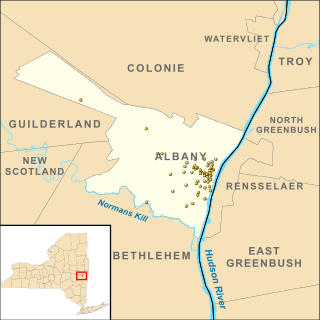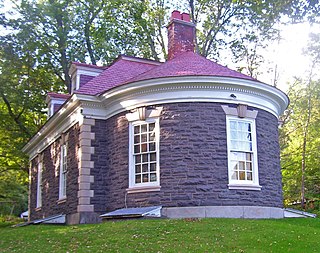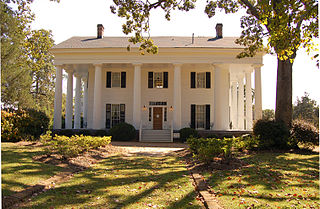
Victorian architecture is a series of architectural revival styles in the mid-to-late 19th century. Victorian refers to the reign of Queen Victoria (1837–1901), called the Victorian era, during which period the styles known as Victorian were used in construction. However, many elements of what is typically termed "Victorian" architecture did not become popular until later in Victoria's reign, roughly from 1850 and later. The styles often included interpretations and eclectic revivals of historic styles (see Historicism). The name represents the British and French custom of naming architectural styles for a reigning monarch. Within this naming and classification scheme, it followed Georgian architecture and later Regency architecture and was succeeded by Edwardian architecture.

Druid Hills Historic District is a historic district in Druid Hills and Atlanta in DeKalb County, Georgia, United States, that is listed on the National Register of Historic Places (NRHP).

Samuel Sloan was a Philadelphia-based architect and best-selling author of architecture books in the mid-19th century. He specialized in Italianate villas and country houses, churches, and institutional buildings. His most famous building—the octagonal mansion "Longwood" in Natchez, Mississippi—is unfinished; construction was abandoned during the American Civil War.
Maple Ridge is a historic district in Tulsa, Oklahoma. It is bounded by the Inner Dispersal Loop on the north, Hazel Boulevard on the south, Peoria Avenue on the east and the Midland Valley Railroad right of way on the west. The northern portion of the district, between 15th Street and 21st Street, has been zoned with Historic Preservation Overlay Zoning by the City of Tulsa and is called North Maple Ridge.

Sunset Park is a neighborhood south of the Historic Downtown of Wilmington, in New Hanover County, North Carolina, United States. It was designated a national historic district on the National Register of Historic Places in 2003.

Glenville Historic District, also known as Sherwood's Bridge, is a 33.9 acres (13.7 ha) historic district in the Glenville neighborhood of the town of Greenwich, Connecticut. It is the "most comprehensive example of a New England mill village within the Town of Greenwich". It "is also historically significant as one of the town's major staging areas of immigrants, predominantly Irish in the 19th century and Polish in the 20th century" and remains "the primary settlement of Poles in the town". Further, "[t]he district is architecturally significant because it contains two elaborate examples of mill construction, designed in the Romanesque Revival and a transitional Stick-style/Queen Anne; an excellent example of a Georgian Revival school; and notable examples of domestic and commercial architecture, including a Queen Anne mansion and an Italianate store building."

There are 77 properties listed on the National Register of Historic Places in Albany, New York, United States. Six are additionally designated as National Historic Landmarks (NHLs), the most of any city in the state after New York City. Another 14 are historic districts, for which 20 of the listings are also contributing properties. Two properties, both buildings, that had been listed in the past but have since been demolished have been delisted; one building that is also no longer extant remains listed.

The United States Post Office and Courthouse is a courthouse of the United States District Court for the Eastern District of North Carolina, located in New Bern, North Carolina. The building was completed in 1935, and was listed in the National Register of Historic Places in 1973, as a contributing building within the New Bern Historic District, and was individually listed in 2018.

Morton Memorial Library is located on Elm Street in Pine Hill, New York, United States. It is a stone building in the Georgian Revival architectural style built at the beginning of the 20th century.

Antebellum architecture is the neoclassical architectural style characteristic of the 19th-century Southern United States, especially the Deep South, from after the birth of the United States with the American Revolution, to the start of the American Civil War. Antebellum architecture is especially characterized by Georgian, Neo-classical, and Greek Revival style homes and mansions. These plantation houses were built in the southern American states during roughly the 30 years before the American Civil War; approximately between the 1830s to 1860s.
Babb, Cook & Willard was a New York City-based architectural firm established in 1884 that designed many important houses and commercial buildings. The principals of the firm were George Fletcher Babb (1836–1915), Walter Cook (1843–1916), and Daniel W. Willard. Willard left the firm in 1908, and was replaced by Winthrop A. Welch. The firm was subsequently renamed Babb, Cook and Welch until 1912, when it became Cook and Welch.

Joseph Florence Leitner was an American architect whose work includes several rail stations. In Columbia, South Carolina he worked for Charles Coker Wilson for five years. Later he partnered with William J. Wilkins (architect), first in Florence, South Carolina and then in an office in Wilmington, North Carolina, where Leitner practiced for a decade. to form Leitner & Wilkins. His work included commercial, educational, fraternal religious, industrial, residential, and transportation buildings in colonial revival architecture, Flemish architecture (especially gables, Italianate architecture and Romanesque revival architecture styles. He ended his career in Florida.

Delaware Avenue Historic District is a national historic district located at Wilmington, New Castle County, Delaware. It encompasses 180 contributing buildings and 1 contributing structure developed in the late-19th and early-20th centuries. The district is primarily residential and includes a variety of Victorian-era mansions and large dwellings in a variety of popular architectural styles including Italianate, Queen Anne, Colonial Revival, Classical Revival, and American Four Square The houses are detached or semi-detached and are primarily three stories in height with extensive wings to the rear. The district also includes 20th century apartment complexes. Also located in the district is the St. Stephen's Lutheran Church and the Sailors and Soldiers Monument. The separately listed Howard Pyle Studios are also located in the district.

Lower Market Street Historic District is a national historic district located at Wilmington, New Castle County, Delaware. It encompasses 132 contributing buildings the central business district of Wilmington. It includes attached commercial and commercial/residential structures dating from the mid-18th to the early-20th century. The buildings reflect a variety of popular architectural styles including Classical Revival, Greek Revival, Federal, and Art Deco. Notable buildings include the Farmers Bank (1912), Jake's Market, Wilmington and Brandywine Bank, Joshua Conner and Sons, J.T. Montgomery Jewelry Store, and Wilmington Publishing Company Building.

City of Camden Historic District is a national historic district located at Camden, Kershaw County, South Carolina. The district encompasses 48 contributing buildings, 8 contributing sites, 2 contributing structures, and 3 contributing objects in Camden. The district is mostly residential but also include public buildings, a church, and a cemetery. Camden's architecture is classically inspired and includes examples of Federal, Greek Revival, and Classical Revival, in addition to cottage-type, Georgian, Charleston-type with modifications, and mansion-type houses. Several of the city's buildings were designed by architect Robert Mills. Notable buildings include the Kershaw County Courthouse (1826), U.S. Post Office, Camden Opera House and Clock Tower, Camden Powder Magazine, Trinity United Methodist Church, St. Mary's Catholic Church, Gov. Fletcher House, Greenleaf Villa, The First National Bank of Camden, and the separately listed Bethesda Presbyterian Church and Kendall Mill.

Alton Lennon Federal Building and Courthouse, also known as the Customs House, is a historic Federal building and courthouse located at Wilmington, New Hanover County, North Carolina. It was designed by the Office of the Supervising Architect under James A. Wetmore and built between 1916 and 1919. It is an imposing three-story, Classical Revival style light sandstone building. It consists of a central mass with balanced projecting wings having engaged pedimented porticos. The design of the front facade of the earlier 1840s customs house is incorporated into the projecting wings to the cast iron details. The building measures 332 feet by 113 feet. The building was named for U.S. Congressman and Senator Alton Lennon (1906-1986) in 1976. It was used as the outside of the courthouse on seasons 7-9 of Andy Griffith's TV series Matlock on ABC.

Carolina Place Historic District is a national historic district located at Wilmington, New Hanover County, North Carolina. The district encompasses 337 contributing buildings in a predominantly residential section of Wilmington. The district developed as Wilmington's first planned streetcar suburb between about 1906 and 1941 and includes notable examples of Queen Anne, Classical Revival, Colonial Revival, and Bungalow / American Craftsman style architecture.

Carolina Heights Historic District is a national historic district located at Wilmington, New Hanover County, North Carolina. The district encompasses 421 contributing buildings, 1 contributing site, and 1 contributing object in a predominantly residential section of Wilmington. The district developed as planned suburban areas between about 1908 and 1950 and includes notable examples of Queen Anne, Classical Revival, Colonial Revival, and Bungalow / American Craftsman style architecture. Notable buildings include the New Hanover High School (1922), the Trinity Methodist Episcopal Church (1921), St. Paul's Episcopal Church (1927/1956-1958), First Church of Christ, Scientist (1928), Sinclair Service Station, and Yopp Funeral Home (1936).

The architecture of Jacksonville is a combination of historic and modern styles reflecting the city's early position as a regional center of business. According to the National Trust for Historic Preservation, there are more buildings built before 1967 in Jacksonville than any other city in Florida, though few structures in the city center predate the Great Fire of 1901. Numerous buildings in the city have held state height records, dating as far back as 1902, and last holding a record in 1981.





















